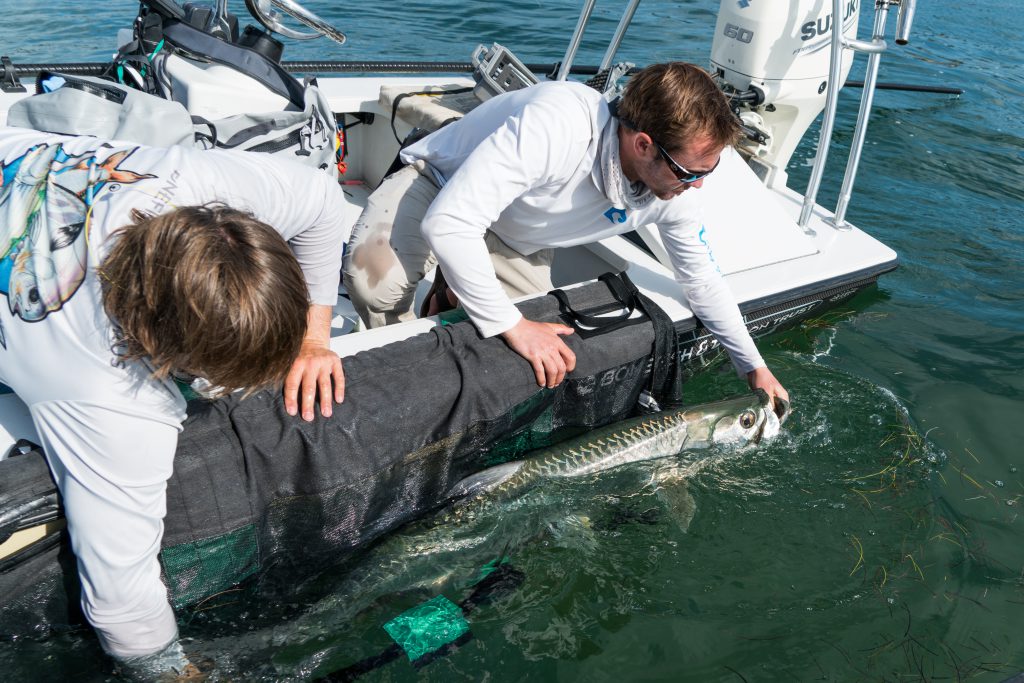To learn more about the BTT Tarpon Acoustic Tagging Program, sponsored by Maverick Boat Group, please join us at the 6th International Science Symposium, November 10-11, at the Bonaventure Resort in Weston, FL. $25.00 Day Passes are available for purchase here. (PC #1 and #2: Tosh Brown)
Filling the Gap: Using Acoustic Telemetry Networks to Track the Movement Patterns of Atlantic Tarpon in the Gulf of Mexico and Western Atlantic
Lucas Griffin
Department of Environmental Conservation, University of Massachusetts Amherst
Aaron Adams, Ph.D
Director of Science and Conservation, Bonefish & Tarpon Trust
Senior Scientist, Florida Atlantic University, Harbor Branch Oceanographic Institute
Jacob Brownscombe, Ph.D.
Institute of Environmental Science, Carleton University, Canada
Steven Cooke, Ph.D.
Institute of Environmental Science, Carleton University, Canada
Andy Danylchuk, Ph.D
Department of Environmental Conservation, University of Massachusetts Amherst
Atlantic tarpon are an extraordinary species—a combination of their size, mirror-like scales, and prehistoric nature has earned them their place as the Silver King of flats fish. The recreational fishery for tarpon has rapidly grown from its beginning in Charlotte Harbor, FL in 1885. In the years since, the fishery has expanded to the Gulf of Mexico, the Caribbean, and as far north as the Chesapeake Bay, with an annual net worth totaling millions of dollars. Considering their allure, wide distribution, importance to coastal economies, and potential ecosystem services, it is critical to continue to fill gaps in what we know about the biology and ecology of Atlantic tarpon so that we can promote the effective management of this recreational fishery for future generations to enjoy.
 Recently, using genetic data collected from over 23,000 tarpon scales, Bonefish & Tarpon Trust researchers, in collaboration with the Florida Fish and Wildlife Conservation Commission (FWC), showed that Atlantic tarpon sampled from the eastern seaboard of the U.S. to Brazil and Africa share the same genetic markers, indicating that there is only one distinct population (i.e., one species) throughout the entire geographic range! Population connectivity within the Atlantic is likely mediated by two tarpon life history traits: the long-distance migration capabilities of adult tarpon and the long-range transport of their planktonic larval via ocean currents. These life history characteristics illustrate the critical importance of international conservation and management needs for Atlantic tarpon, ensuring the protection of this species across political jurisdictions and geographic boundaries.
Recently, using genetic data collected from over 23,000 tarpon scales, Bonefish & Tarpon Trust researchers, in collaboration with the Florida Fish and Wildlife Conservation Commission (FWC), showed that Atlantic tarpon sampled from the eastern seaboard of the U.S. to Brazil and Africa share the same genetic markers, indicating that there is only one distinct population (i.e., one species) throughout the entire geographic range! Population connectivity within the Atlantic is likely mediated by two tarpon life history traits: the long-distance migration capabilities of adult tarpon and the long-range transport of their planktonic larval via ocean currents. These life history characteristics illustrate the critical importance of international conservation and management needs for Atlantic tarpon, ensuring the protection of this species across political jurisdictions and geographic boundaries.
Although the recent genetic data points to broad scale connectivity, there is still a considerable knowledge gap about how Atlantic tarpon move regionally and how they use habitat across various life stages (i.e., juvenile, sub-adult, adult). Such detailed information about the movement ecology is vital to informing conservation efforts and prioritizing those that best protect the species and this valuable fishery. Recognizing this need, Bonefish & Tarpon Trust launched a long-term Tarpon Acoustic Telemetry Tagging Project in March 2016 in collaboration with research teams at the University of Massachusetts Amherst and Carleton University, as well as with the generous support of the Maverick Boat Group. This project will help determine if tarpon use the same spawning site each year or move among spawning sites, how changes in freshwater flows into coastal waters influence tarpon movements, and the movement patterns and habitat use of mid-size tarpon (30-50 pounds), which are the future of the fishery and very susceptible to being harmed by changes in coastal habitats and water quality.
The tagging process involves surgically implanting acoustic transmitters that have a 5-year battery life into Atlantic tarpon after they are caught by anglers and guides. Each transmitter emits a unique ultrasonic acoustic signal approximately every 90 seconds that can be detected by specialized autonomous receivers moored on the seafloor. A tagged fish must be within range of a receiver to be detected; this range varies from 50 to over 1000 yards depending on environmental conditions, such as water depth and wave action. When detected, the receiver also records the date and time, allowing us to track each individual tarpon for years to come. In collaboration with guides and anglers, receivers have been deployed in tarpon ‘hotspots’ in the Florida Keys, Charlotte Harbor, Apalachicola, Georgia, and South Carolina. Chances are that a few of your favorite tarpon spots likely have a receiver stationed nearby. In addition to the Bonefish & Tarpon Trust sponsored receivers, an extensive collaboration of state agencies and university researchers have deployed over 1,300 receivers across Gulf of Mexico and over 3,000 receivers along coastal southeastern US. Since these receivers can detect any fish containing an acoustic transmitter, we are able to maintain extensive detection coverage of our tagged tarpon well beyond that of our own receivers. Given the distribution of the receivers, data from this network will not only reveal information about broader movement patterns, but also fill in critical gaps about the inshore ‘spatial ecology’ of Atlantic tarpon, including smaller individuals in the 30-80 lb range.
 To date, we have tagged nearly 50 tarpon off the coasts of Charlotte Harbor, the Florida Keys, Georgia, and South Carolina, all ranging from 30 – 160 lbs. While movement data collected by acoustic telemetry takes time to collect and must be physically downloaded from the receivers, we are already beginning to gather a considerable amount of preliminary data. From the first 12 fish tagged and tracked, we are beginning to map a diverse range of movement types. Notably, we have observed fish tagged from multiple locations overlapping in areas along the Florida Key, such as the Bahia Honda Channel. One fish tagged in northeastern Florida even wintered inside this channel as well. For fish in the 50-70 lb size range, preliminary analyses is revealing that their movement patterns are a combination of extensive migrations and localized ‘breaks’ for extended periods of time. For example, a 60 lb Atlantic tarpon (named Helios) traveled 800 miles from the Lower Keys to North Carolina in just 41 days (an average of 20 miles per day)! Helios was detected heading south in the fall and winter, and most recently detected again in the Keys. Another 60 lb Atlantic tarpon (#04) tagged in Charlotte Harbor, underwent an impressive migration from western Florida to eastern Florida and back west to the Everglades where it made routine 2-12 mile forays into tidal rivers between December and March.
To date, we have tagged nearly 50 tarpon off the coasts of Charlotte Harbor, the Florida Keys, Georgia, and South Carolina, all ranging from 30 – 160 lbs. While movement data collected by acoustic telemetry takes time to collect and must be physically downloaded from the receivers, we are already beginning to gather a considerable amount of preliminary data. From the first 12 fish tagged and tracked, we are beginning to map a diverse range of movement types. Notably, we have observed fish tagged from multiple locations overlapping in areas along the Florida Key, such as the Bahia Honda Channel. One fish tagged in northeastern Florida even wintered inside this channel as well. For fish in the 50-70 lb size range, preliminary analyses is revealing that their movement patterns are a combination of extensive migrations and localized ‘breaks’ for extended periods of time. For example, a 60 lb Atlantic tarpon (named Helios) traveled 800 miles from the Lower Keys to North Carolina in just 41 days (an average of 20 miles per day)! Helios was detected heading south in the fall and winter, and most recently detected again in the Keys. Another 60 lb Atlantic tarpon (#04) tagged in Charlotte Harbor, underwent an impressive migration from western Florida to eastern Florida and back west to the Everglades where it made routine 2-12 mile forays into tidal rivers between December and March.
While this information only reflects a small portion of our preliminary findings, we are already very encouraged by the incoming data and how it will contribute to the management and conservation of Atlantic tarpon. We are also incredibly inspired by the far-reaching collaborative efforts between guides, anglers, donors, and cross-institutional research colleagues that are helping us with this study. Stay tuned for much more to come!
We thank donors for their critical support and sponsorship of individual tarpon tags or receivers. Donors are now able to sign-on to a private web portal to view general movements of their sponsored fish. This project would not be possible without the support of the many fishing guides across the Gulf of Mexico, the Florida Keys, and up the southeastern coast.
We would also like to thank the following Captains: Carl Ball, Will Benson, Shelby Bentley, Jordan Carter, Bruce Chard, Scott Collins, Brandon and Jared Cyr, Joel Dickey, Danny Flynn, Ron Gibson, Kevin Grubbs, Travis and Bear Holeman, Adam Hudson, John Jackson, Brian Jill, Rob Kramarz, Austin Lowder, David Mangum, Augie Moss, Gabe Nyblad, Jordan Pate, Albert Ponzoa, Zach Stells, Jason Sullivan, J.R. Waits, and Newman Weaver. (PC #3: Andy Danylchuk, Ph.D)




